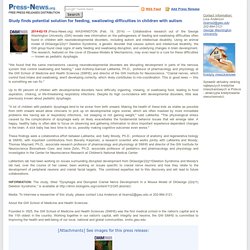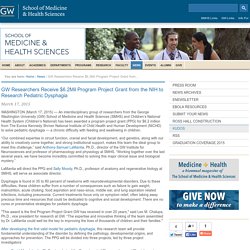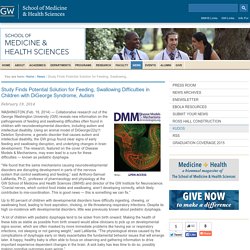

Study finds potential solution for feeding, swallowing difficulties in children with autism. (Press-News.org) WASHINGTON (Feb. 19, 2014) — Collaborative research out of the George Washington University (GW) reveals new information on the pathogenesis of feeding and swallowing difficulties often found in children with neurodevelopmental disorders, including autism and intellectual disability.

Using an animal model of DiGeorge/22q11 Deletion Syndrome, a genetic disorder that causes autism and intellectual disability, the GW group found clear signs of early feeding and swallowing disruption, and underlying changes in brain development. The research, featured on the cover of Disease Models & Mechanisms, may even lead to a cure for these difficulties — known as pediatric dysphagia. Up to 80 percent of children with developmental disorders have difficulty ingesting, chewing, or swallowing food, leading to food aspiration, choking, or life-threatening respiratory infections.
GW Researchers Receive $6.2Mil Program Project Grant from the NIH to Research Pediatric Dysphagia. WASHINGTON (March 17, 2015) — An interdisciplinary group of researchers from the George Washington University (GW) School of Medicine and Health Sciences (SMHS) and Children’s National Health System (Children’s National) has been awarded a program project grant (PPG) for $6.2 million from The Eunice Kennedy Shriver National Institute of Child Health and Human Development (NICHD) to solve pediatric dysphagia — a chronic difficulty with feeding and swallowing in children.

“Our combined expertise in circuit function, cranial and facial development, and genetics, along with our ability to creatively come together, and strong institutional support, makes this team the ideal group to meet this challenge,” said Anthony-Samuel LaMantia, Ph.D., director of the GW Institute for Neurosciences and professor of pharmacology and physiology at SMHS. “Working together over the last several years, we have become incredibly committed to solving this major clinical issue and biological mystery.” Study Finds Potential Solution for Feeding, Swallowing Difficulties in Children with DiGeorge Syndrome, Autism. WASHINGTON (Feb. 19, 2014) — Collaborative research out of the George Washington University (GW) reveals new information on the pathogenesis of feeding and swallowing difficulties often found in children with neurodevelopmental disorders, including autism and intellectual disability.

Using an animal model of DiGeorge/22q11 Deletion Syndrome, a genetic disorder that causes autism and intellectual disability, the GW group found clear signs of early feeding and swallowing disruption, and underlying changes in brain development. The research, featured on the cover of Disease Models & Mechanisms, may even lead to a cure for these difficulties — known as pediatric dysphagia.
Up to 80 percent of children with developmental disorders have difficulty ingesting, chewing, or swallowing food, leading to food aspiration, choking, or life-threatening respiratory infections. Superbugs could be defeated by fecal transplantation. Fecal transplants in mice cleared K. pneumoniae in the intestines.

In humans, stool transplants have been effective against C. difficile. The study in mice has been published in PLOS Pathogens. What is periodontitis? What causes periodontitis? Periodontitis means "inflammation around the tooth" - it is a serious gum infection that damages the soft tissue and bone that supports the tooth.

All periodontal diseases, including periodontitis, are infections which affect the periodontium. The periodontium are the tissues around a tooth, tissues that support the tooth. With periodontitis, the alveolar bone around the teeth is slowly and progressively lost.